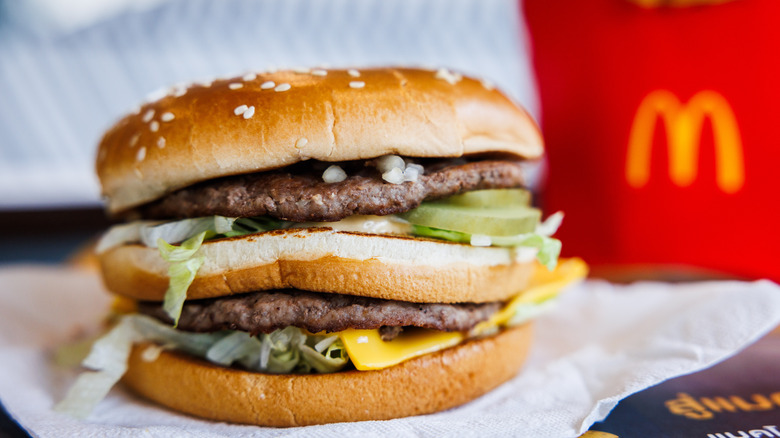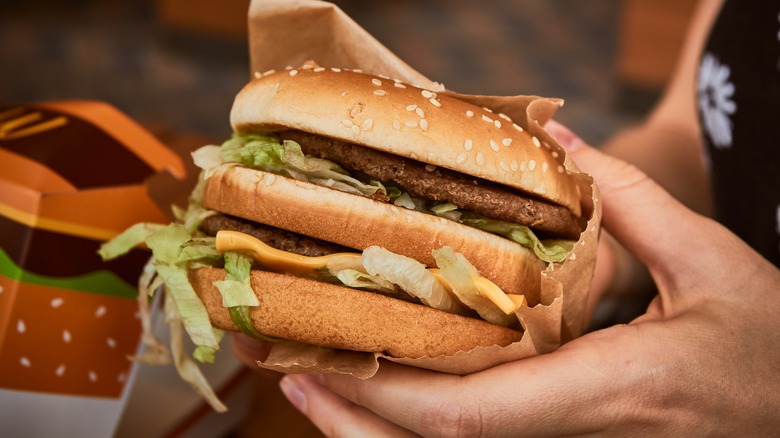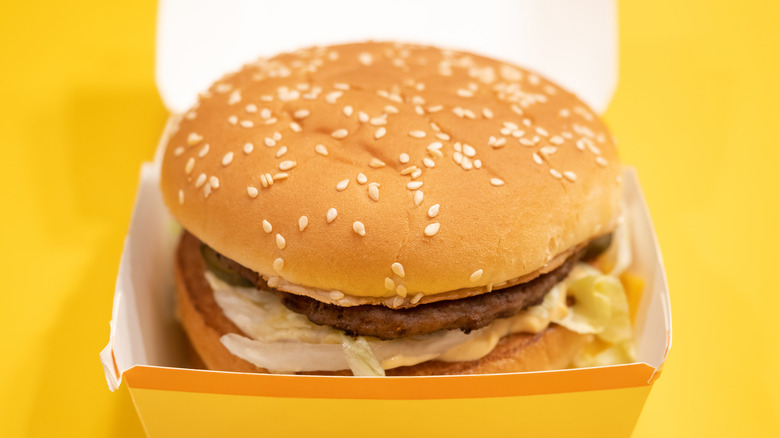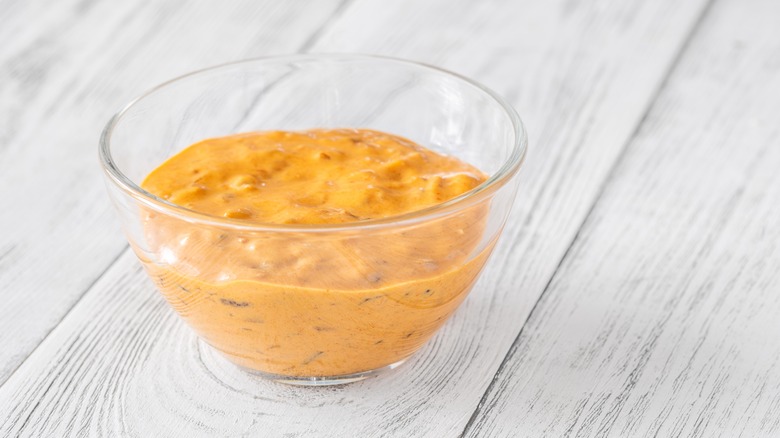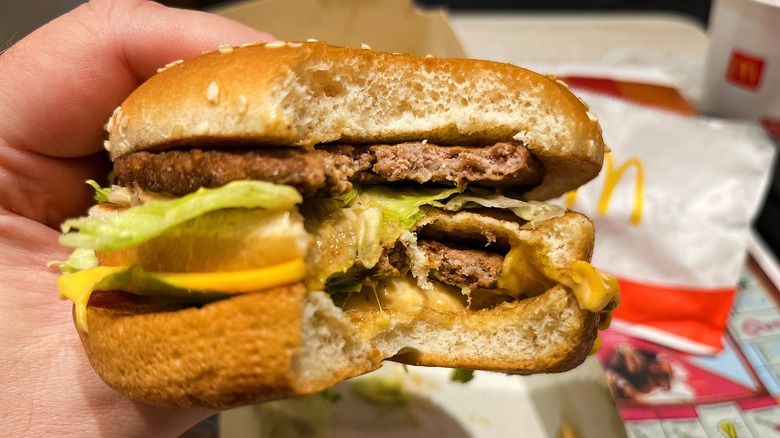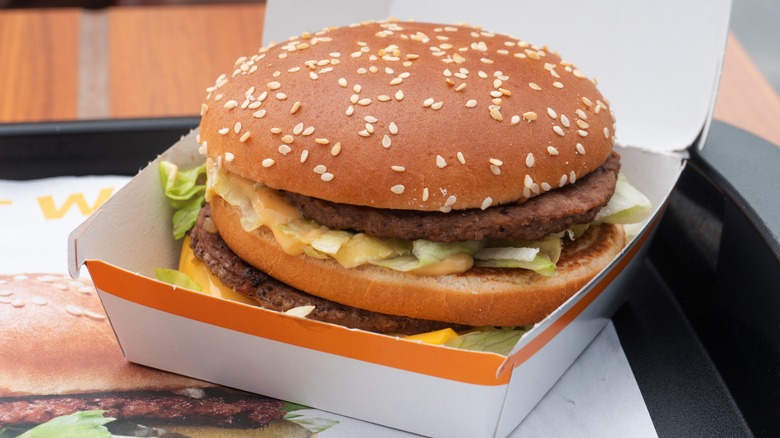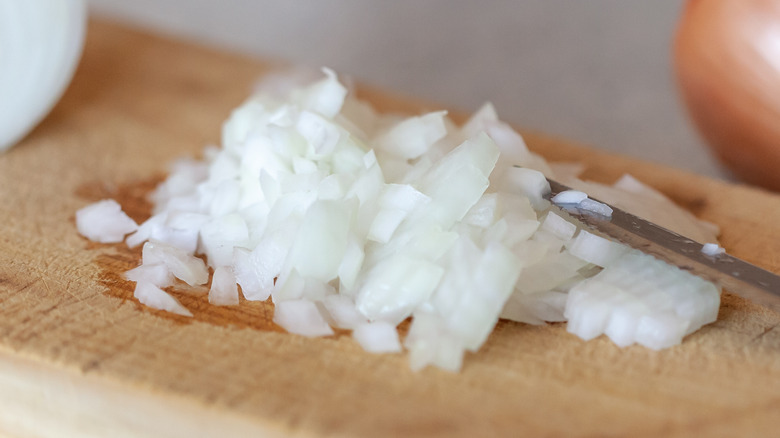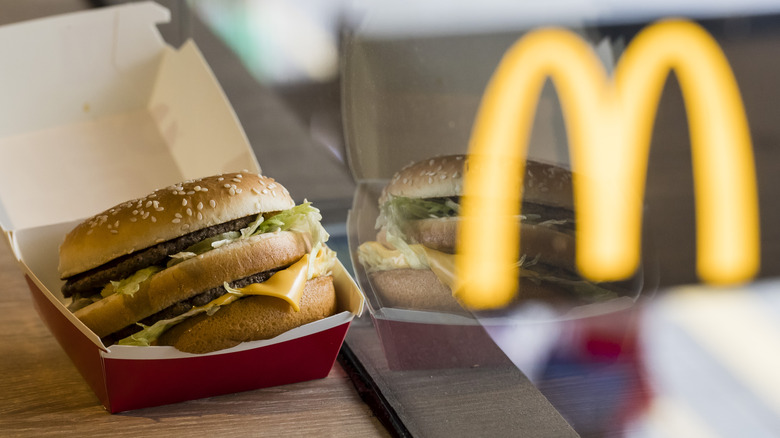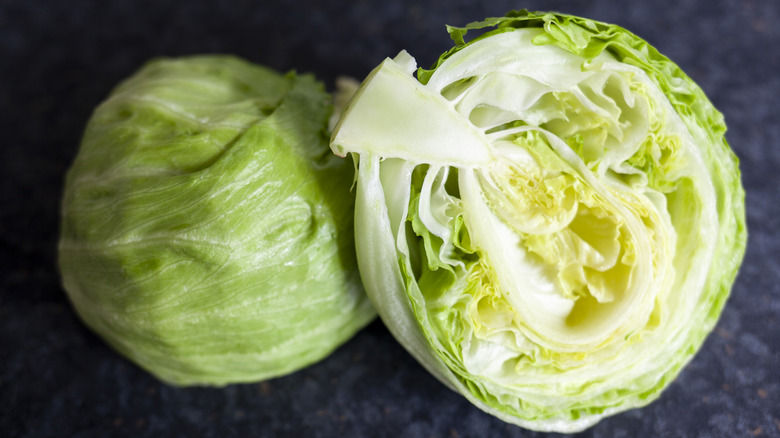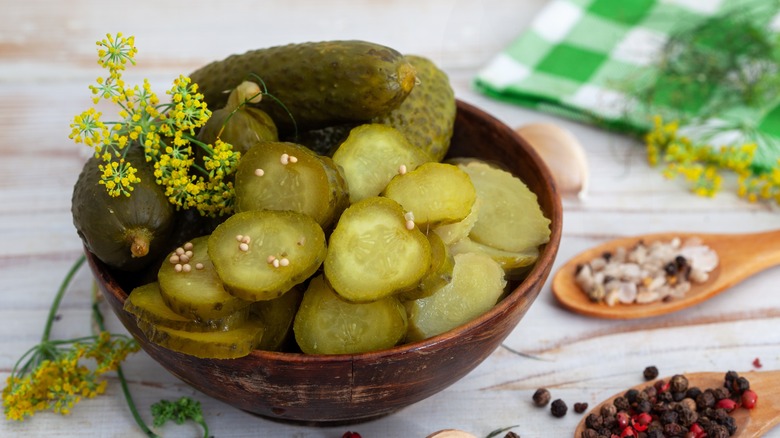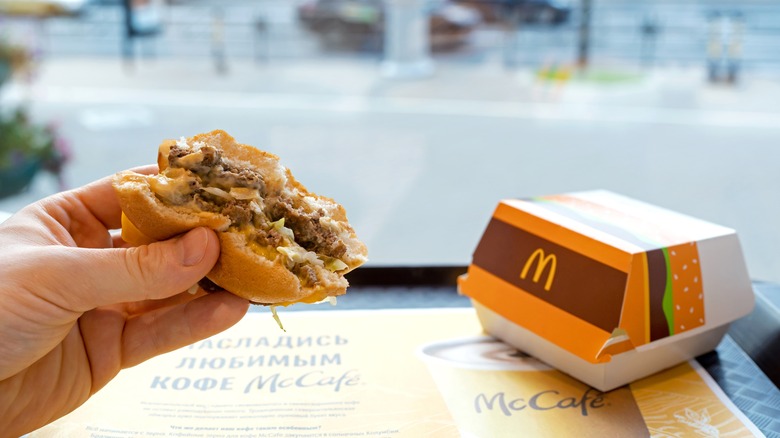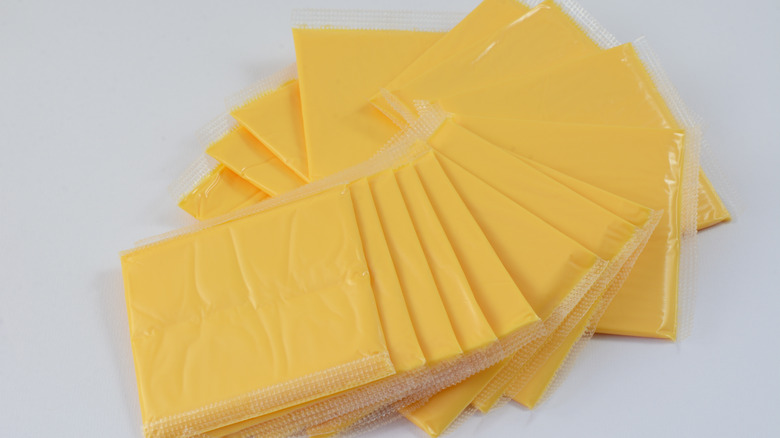What Really Makes McDonald's Big Mac So Delicious?
As cultural icons go, you don't get much bigger than the Big Mac. Perhaps the most well-known burger in the world, that was originally created for steel workers, this McDonald's sandwich has been a regular order for millions of people ever since it first made its way onto the chain's national menu in 1968. Nowadays, approximately 550 million Big Macs are sold in the United States every year, which means that McDonald's is churning out 17 of its burgers every single second. The reason it's so popular? Because it just tastes really, really good.
With the Big Mac, McDonald's achieved the unachievable: A burger that feels big and yet manageable, satisfying without being too hefty, and flavorful without being overwhelming. It did this by perfectly refining its dimensions and flavor elements, with its beef patties, cheese, and its famous special sauce all providing specific taste notes. What goes into making each of these ingredients, though — and how do they come together in perfect harmony? As someone who's eaten hundreds of Big Macs in my time, and has spent more time than I'd care to admit examining exactly what goes into making it so delicious, I took it upon myself to investigate precisely why this burger tastes so good.
The patties are 100% real beef
All McDonald's beef burgers start with the perfect patty, and the chain spends a lot of time getting its meat just right. Although it's tempting to write off McDonald's burgers as cheap or full of filler, McDonald's patties really are made with 100% real beef. No extra ingredients go into the meat, and there are no additives or preservatives keeping it fresh for longer. Instead, once each patty is formed, it's flash frozen and kept at sub-zero temperatures until it's ready to be cooked.
Keeping the beef unadulterated means that there are no strange flavors in the mix, and instead the Big Mac has a deep, meaty richness. This richness is then offset by the sharp Big Mac sauce and the saltiness of the cheese. It also helps that the burger patties at McDonald's are way thinner than you'd find at other restaurants, which adds to the harmony of the sandwich. By not overwhelming the Big Mac with massive patties, everything stays well-proportioned, and the beef notes don't dominate its flavor. The dual patty approach that the sandwich takes makes it a prominent presence, but because they're kept apart by the middle slice of bread, they don't coagulate into one big lump. It's kind of a science, people.
The sesame seed bun is well-toasted
The bun you use makes a big difference to any burger, and things are no different with the Big Mac. The sandwich's three-part sesame seed bun gives the burger a slightly nutty fragrance and taste, adding an undercurrent of flavor and aroma that rounds out the taste of the beef and sauce. It's all made so much better by the fact that it's toasted, too. When the Big Mac is made, McDonald's staff feed each piece of the bun (the "crown," the "club," and the "heel," in case you wanted the technical language) through a toasting machine, and they're spat out with a golden-brown, crispy surface.
@foodfvcks
The question of whether to toast or not to toast is a big question when it comes to burger buns, but in the case of the Big Mac it's a no-brainer. Toasting the bun makes it more robust, increasing its ability to keep its shape when sitting in the box. It also helps to prevent any sauce or fat from making the buns too moist, which is particularly essential for the "club," which could be in danger of becoming wet and gluey. Plus, the smoky taste that's created by toasting the bun deepens its sesame notes and pairs excellently with the similarly-smoky beef flavor.
It's all down to that sauce
There's a reason why McDonald's protects the secret recipe for its Big Mac sauce so carefully: There's nothing quite like it. This sauce sets Big Macs apart from all the other burgers on the menu, with its sweet-sour, creamy, and savory notes creating a huge amount of flavor. McDonald's Big Mac sauce came to be when two different sauces were combined in the early 1970s by then-CEO Ray Kroc. While it went through a recipe change in the '90s, customers weren't fans of the new taste, and by 2004 the Big Mac sauce was back to its original formulation.
Pinning down the exact flavor of Big Mac sauce is pretty tricky, and because of its taste notes and orange-pink color, a lot of people just assume that it's Thousand Island or Russian dressing. There's a little bit more to it than that, though. Unlike both of those dressings, there isn't any ketchup in the Big Mac sauce, with former McDonald's chefs revealing that it gets its color solely from paprika. Big Mac sauce also has garlic notes in it, and gets its tanginess from sweet pickle relish, mustard, and white wine vinegar. As with all corporate secrets, it's hard to tell whether any of the leaked Big Mac sauce recipes out there are totally accurate. One thing's for sure, though: It adds layers of flavor and a moistness to this burger that makes it totally dynamite.
With the Big Mac, ratios are everything
The Big Mac is one of those burgers that shouldn't work, but does: I can't count the amount of times where I've considered how I'm gonna fit it all in my mouth, before proceeding to take a perfectly-formed bite from it. While there are hacks for getting an even bigger Bic Mac, there's really no need as the reason why it's so manageable is because of its ratios. The Big Mac is a big burger, but all of its ingredients are perfectly portioned so that it doesn't get too towering, and so that no one flavor overwhelms. Instead, everything remains in harmony, the burger doesn't bulge too much, and you get every individual taste.
In fact, it's interesting how sparingly McDonald's uses some of its ingredients. Each Big Mac has just a tiny sprinkling of dehydrated onions, two thin pickles, and a single slice of cheese per burger. Lettuce is kept to about ½-ounce per bun, too. These smaller amounts are by design, though. By keeping the sharper vegetables and cheese to a minimum, they provide pops of flavor without overwhelming one another. The lettuce, meanwhile, delivers that all-important crunch without making the burger too tall.
The center slice isn't just a gimmick — it plays a key role
The Big Mac is set apart by its "club," the slice of bread in the middle of the sandwich that makes it taller than the rest. If you've ever thought that the burger would be just fine without it, though, you'd be mistaken. The creator of the Big Mac, Jim Delligatti, says that the use of the club slice occurred during its development period, when the restaurant found that things were getting unwieldy. "The first day we just used the regular bun, we didn't have any center (bread) slice," Delligatti stated to Reuters back in 2007. "Making it that way made it very sloppy. The next day we put the center slice in, and today it looks the same."
The center slice gives the Big Mac all-important structure while also keepings its ingredients separate. Without it, each mouthful would become a mushy mass of beef and lettuce and be plain old unpleasant to eat. It also acts as a receptacle for another squirt of Big Mac sauce, which distributes flavor throughout the burger more evenly. Aside from all this? It also makes the Big Mac look pretty impressive — and as we eat with our eyes first, this really shouldn't be underestimated.
Don't forget about the onions
If you've ever ordered a Big Mac without onions (as I once did, rather tragically), you'll know how different its flavor is. An onionless Big Mac removes a certain amount of punch, and turns it into a fairly bland burger — and with the onions, the sandwich has a sharpness and brininess that makes it taste a little lighter. Incredibly, too, the onions don't leave you with pungent onion breath, or make the burger too acrid. That's because they've been dehydrated (and rehydrated) before they hit the bun.
Dehydrating onions changes their flavor significantly. When you dry out onions and remove their moisture, you also take away their bite and acidity, while retaining their sweetness and floral aroma. The dehydrated onions are shipped to McDonald's restaurants in their dried form, where they're soaked in water by the employees to bring them back to life. They're then sprinkled onto your Big Mac, before being topped with the other ingredients. This dehydration process also controls the flavor of the onions, meaning that Big Macs from different locations won't have a more oniony flavor — each sandwich tastes as good as the last.
The basic recipe hasn't changed in decades
Like many cultural monoliths, the Big Mac has thrived on its reliability. No matter where you are in the country, you can be sure that the burger looks and tastes the same -– and you've been able to trust that fact for as long as you remember, right? That's because a huge part of the Big Mac's success is in the fact that it's remained consistent throughout the years, with its basic recipe largely unchanged for half a century. Although McDonald's has slightly altered its ingredients here and there to adjust its nutritional impact, how the burger itself is made has stayed constant and predictable.
If you're wondering how this makes a Big Mac delicious, well, it's all down to psychology. Big Macs are, for many people, the ultimate comfort food. Aside from its high-fat, salty nature being immediately satisfying, some folks like myself may have treasured memories of eating this burger with their families and friends. Each time we eat that same burger or smell its distinctive smell, we're thrown into an experience that combines food with a trip down memory lane. Simply put, the Big Mac makes us taste our childhoods.
McDonald's treats its lettuce well
The lettuce in a burger can be a total afterthought — but not with the Big Mac. One of my favorite things about eating this sandwich is experiencing the interplay between the crunchy, firm lettuce and the softer meat, cheese, and bun, giving it a two-tone texture that heightens the senses. You don't get that without good-quality lettuce, and luckily McDonald's knows how to obtain it, by working with trusted suppliers that care deeply about their produce.
Farmed Dirk Giannini is one such supplier. "To produce high-quality lettuce, the attention to detail is demanding, and we are here every day making sure we can make that happen for McDonalds," says Giannini via the McDonald's website. Giannini and his workers move quickly to deliver their lettuce to restaurants shortly after it's been harvested to avoid it wilting. It's that freshness that shines in a Big Mac, with the lettuce not just staying crisp but tasting sprightly. This prevents the burger from getting too heavy, and allows you to fool yourself into thinking that it's a little bit healthy.
The pickles add a surprising amount of flavor
Arguably the most controversial ingredient in a Big Mac, the two pickle slices that go into each sandwich do a lot of heavy lifting flavor-wise. While they may be small, they give the a shot of vinegary flavor. McDonald's uses dill pickles in its Big Macs, and the addition of that small herb makes a big difference. The dill in the recipe adds a floral, almost aniseed undertone to the pickles' flavor, which cuts through the acidity and adds an herbal texture to the burger.
While you can order your Big Mac without pickles — and indeed, many people do — you really miss out by doing so. The pickle slices highlight the acidic notes in the Big Mac sauce and somehow intensify it, with the pair of ingredients then working to cut through the smoky flavors of the beef and toasted bun. They also pair well with the acidity of the cheese slice, with their sweetness balancing with its saltiness. Don't get me wrong, though: I won't judge you if you ask for your server to leave the pickles out. I'll just ask them to put the slices in my burger, instead.
Each topping is prepared with bite in mind
Eating a Big Mac without making a huge mess might seem like a challenge: After all, with a burger that has so many components, how's it gonna stay intact? Luckily, it does so pretty easily, thanks to how every topping is prepared. There are no chunky onion rings, huge lettuce leaves, or overly-thick pickle slices here, folks. In a Big Mac, each topping is cut down to bitesize proportions, meaning that every time you chomp into it, you're not dragging them out with your teeth.
This has a big effect on the burger's flavor. By ensuring that each topping is cut down to smaller proportions, the Big Mac's distribution of flavor remains consistent. Every bite tastes the same and has roughly the same amount of ingredients, making it an enjoyable, harmonious experience from start to finish. You're also not left with a pile of toppings on your lap and an annoying clean-up operation.
The cheese slice adds saltiness and tanginess
The Big Mac is technically a cheeseburger, but it's fair to say that the cheese definitely isn't the star of the show. That doesn't mean it doesn't have a big impact, though. The single slice of American cheese that goes into each Big Mac fills it with salty, sharp flavor. Nestled at the very bottom of the burger, it acts as a bed for the other ingredients, both in terms of flavor and structure. It doesn't dominate the sandwich, but amps up its taste considerably.
Interestingly, McDonald's doesn't use the same cheese in its Big Mac across the world. In the UK, for example, American cheese is replaced with a slice of cheddar. However, if you think you're being shortchanged by only getting American in your sandwich, think again. American cheese doesn't have the best reputation but its soft and silky nature works perfectly here, adding smoothness to the burger and coming away in each mouthful easily. Other cheeses would simply be too dense and hard, and stick out like a sore thumb in the sandwich. If you're trying to make your own Big Mac at home, you can also find copycat McDonald's American cheese in your local Walmart.
